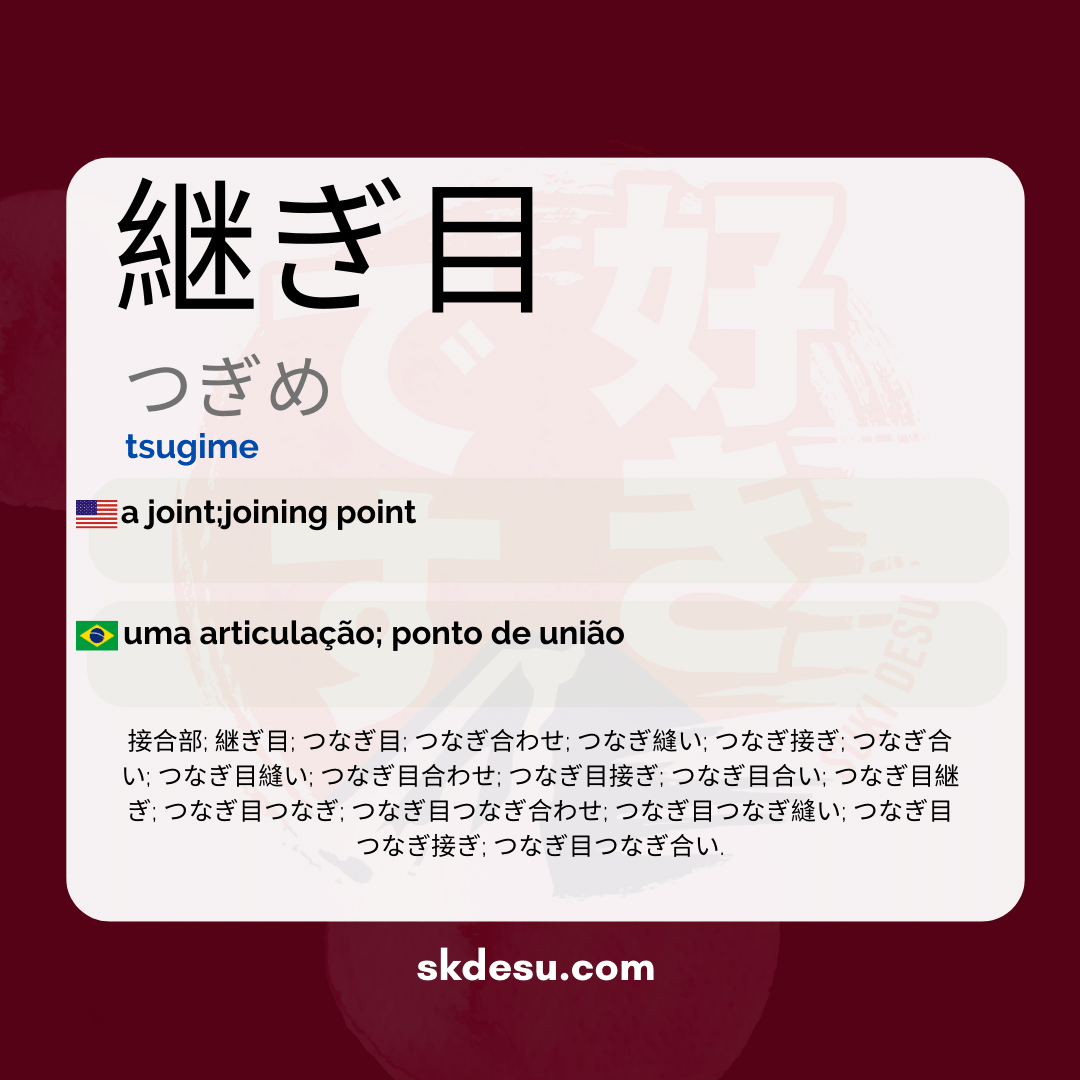Translation and Meaning of: 継ぎ目 - tsugime
If you are studying Japanese or are curious about the language, you may have come across the word 継ぎ目 (つぎめ, tsugime). It may seem simple at first glance, but it carries interesting nuances in the language and Japanese culture. In this article, we will explore its meaning, origin, everyday use, and even tips for memorizing it effectively. Whether to expand your vocabulary or better understand Japanese, this guide will help you master this word.
Meaning and usage of 継ぎ目 (つぎめ)
The word 継ぎ目 refers to a "joint," "splice," or "point of connection" between two parts. It is used both in a physical sense, such as in seams or repairs, and in an abstract sense, such as in transitions or changes. For example, it can describe the line where two pieces of fabric are sewn or even the moment when a story changes chapters.
In everyday life, the Japanese naturally use つぎめ, especially in practical contexts. If you have ever watched a video on Japanese crafts or carpentry, you've probably heard the term mentioned. Its application ranges from household repairs to more metaphorical discussions, such as in literary narratives.
Origin and writing of kanji
The kanji 継 (tsugu) means "to inherit" or "to continue," while 目 (me) represents "eye" or, in this case, "point." Together, they form the idea of a "place where something is continued." This composition reflects well the meaning of the word, as a junction is precisely the point where two parts meet to move forward.
It is worth noting that 継ぎ目 is a common word, but it is not among the most frequent in Japanese. It appears more in specific contexts, such as manuals, technical dialogues, or detailed descriptions. Nevertheless, understanding it is essential for those who want to delve deeper into the language.
Tips for memorizing and using 継ぎ目
An effective way to remember つぎめ is to associate it with concrete situations. Think of everyday objects that have seams, such as patched clothes or restored furniture. Visualizing these examples helps to intuitively memorize the term. Another tip is to practice with simple sentences, like "この継ぎ目は目立たない" (This seam is inconspicuous).
Interestingly, 継ぎ目 also appears in less literal expressions. In some animes or dramas, it can be used to describe transition moments in the plot. This broader usage shows how the Japanese language takes advantage of concrete terms to express abstract ideas, further enriching its vocabulary.
Vocabulary
Expand your vocabulary with related words:
Synonyms and similar words
- 接合部 (Setsugōbu) - Connection or junction point.
- 継ぎ目 (Tugime) - Seam; specifically the line where two parts meet.
- つなぎ目 (Tsunagime) - Connection point; it can refer to any type of link between parts.
- つなぎ合わせ (Tsunagiawase) - Join or connect parts; emphasizes the act of uniting.
- つなぎ縫い (Tsunaginui) - Joint sewing; specific to the sewing technique that joins parts.
- つなぎ接ぎ (Tsunagipagi) - Junctions made by connection; emphasizes the technique of joining through sewing or gluing.
- つなぎ合い (Tsunagia) - Mutual connection or interlinking; implies interdependence between the parts.
- つなぎ目縫い (Tsunagimenui) - Sewing at the joints; focuses on the sewing technique in the connection areas.
- つなぎ目合わせ (Tsunagimeawase) - Alignment of joints; emphasizes the act of adjusting the parts so that they join correctly.
- つなぎ目合い (Tsunagimeai) - Compatibility in joints; it focuses on how the parts fit together.
- つなぎ目継ぎ (Tsunagimegugi) - Joint stitching; similar to joint, but emphasizes a specific stitching method.
- つなぎ目つなぎ (Tsunagimetsunagi) - Joint connection; it implies a continuous connection between the parts.
- つなぎ目つなぎ合わせ (Tsunagimetsunagiawase) - Union of junctions; highlights the unification of different connections.
- つなぎ目つなぎ縫い (Tsunagimetsunaginui) - Continuous joining stitch; emphasizes the continuous way of joining parts through stitching.
- つなぎ目つなぎ接ぎ (Tsunagimetsunagipagi) - Unified connection of joints; highlights the multilayer joining technique.
Romaji: tsugime
Kana: つぎめ
Type: noun
L: jlpt-n1
Translation / Meaning: articulation; joining point
Meaning in English: a joint;joining point
Definition: A piece where pieces of different materials or shapes are joined.
Quick Access
- Vocabulary
- Writing
- Sentences
How to Write in Japanese - (継ぎ目) tsugime
See below a step-by-step guide on how to write the word by hand in Japanese. (継ぎ目) tsugime:
Example Sentences - (継ぎ目) tsugime
See below some example sentences:
Kono fuku no tsugime wa totemo kirei desu
The stitching on this outfit is very beautiful.
The stitching on this outfit is very beautiful.
- この - indicates proximity, meaning "this"
- 服 - means "clothing"
- の - particle indicating possession, meaning "from"
- 継ぎ目 - means "sewing, joining"
- は - Particle indicating the topic of the sentence
- とても - adverb meaning "very"
- きれい - adjective meaning "beautiful, clean"
- です - verb to be in the polite form
Other Words of this Type: noun
See other words from our dictionary that are also: noun

